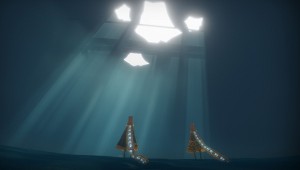What do the Star Trek-like future, the Star Wars-like future, Modern military conflict, Medieval Europe, Feudal Japan, and Norse mythology have in common? They are all the small crop of settings used in video games and it seems that few games ever seem to deviate from these places. While it is true that people have a tendency to stick with the familiar, it will not do games any good unless it can use the potential of cultures, stories, and settings that don’t require constant, jingoistic hyper patriotism that gives permission to shoot at anything that moves because it allegedly threatens freedom.
The first two great examples of games that have come out of individual experiences is Papo & Yo. The concept and design by Vander Caballero, he takes the player into a distinctly Brazilian townscape in the dreams of a boy named Quico and a large monster that represents the abusive father Quico dreams to escape from. While certainly not the best puzzle game, it was a deeply personal story that allowed those who wished to understand the mindset of someone in that situation and bring to light how complex familial relationships can be. Everything in the game is drawn from the mind of Caballero and he admits to it being fortunate that Sony gave him the chance to tell his story. It is currently available on PSN, Steam, and OS X.
The second example is Guacamelee by Drinkbox Studios. It is a homage to past Metroidvania titles that still carry weight in games today, but they are usually science fiction, or the now sadly discontinued 2-D Castlevania games that seem to want to do nothing else but 3D. It takes the story of a humble farmer as he becomes a mighty Luchador, traveling between the worlds of the Living and the Dead, to save El Presidente’s daughter. The colors are vibrant, the art style is playful, and overall, the game is fun. It is also available on Playstation Vita, Playstation 3 and 4, Steam, OS X, Wii U, Xbox 360 and Xbox One. In addition, it has received a content update and has been upgraded to Gold Edition. Any fan of Metroid would be doing a disservice to not at least give it a chance.
Coming in November, another game that has been making the rounds of gaming media as something to watch is Never Alone. Natives of Alaska live the stories with the environment and pass them down orally from one generation to the next. What makes Never Alone stand out is the fact that the designers worked in tandem with the local Iñuipaq Storytellers over the course of two years to tell a folk legend of an all-consuming blizzard and a young girl’s quest, aided by her ally, the fox, to ensure the safety of her people.
Yes, there is the possibility that these games will not sell, nor will they reach the kind of threshold that they would deserve to. Perhaps that may not be the end of the world if it did. While making these games does carry a specific idea to hopefully recoup the costs from sales, these games have an additional purpose. Those that design them want to show their stories to a world that does not get a chance to see it as much as they would like.
For this article, Elizabeth LaPensee was asked to provide some additional insight for how to merge gaming with cultural history and she had this to say:
“Indigenous stories, language, and values can inspire new forms of games and gameplay. For example, I recently worked on a board game about Pacific Northwest Native foods for the Northwest Indian College. The Gift of Food’s gameplay includes collaboration, generosity, gratitude, and stewardship. The art is beautiful and uniquely represents six eco-systems thanks to collaborating with Roger Fernandes, a storyteller of the Lower Elwha Band of the S’Klallam Indians in Washington.”
She also has a game of her own in the works:
“I’m currently prototyping a game that explores stories about spacecanoes and Star People. Since it’s important to protect these stories while passing on the teachings, the game design is based on non-linear storytelling. The art style comes from my own background as both Anishinaabe and Métis, honoring beadwork and acknowledging the role of copper in expressing spirit.” Her video showcases an early prototype of the artstyle she intends to use which brings some of the more important aspects of the culture to life.
Like many storytellers, she wants to make it clear that her vision for the game will not require many of the pitfalls that modern game development currently suffers from.
“As an Indigenous indie developer, I don’t need a huge budget and AAA quality graphics. Inspiration is a gift from ancestors and I continue this good work for the next generations in new forms.”
And this is just scratching the surface.
Yes, the possibility of any of the larger publishers trying to push this onto their platforms with their gargantuan budgets, hoping for a blockbuster is next to nil. However, that is not what these games are trying to do. It does seem naive, even foolhardy, that games could lead to some sort of cultural bridgework to learning the stories and histories of other cultures, however, when it is done right, the chances of these reaching more people becomes much more likely.
To close; what must be reiterated to developers that in the creation of these games that feature cultures that are not so widely known in the game industry, is that the communities that represents these cultures in real life must be involved. This is beyond must. This is beyond vital. This is what makes the difference between making a truly compelling gateway into another facet of humanity that was never before explored and a pandering waste of time that has been the standard for too many years. It brings to mind an NES game that is better off forgotten and left to rot in the dust. Gaming can do better, and hopefully, it will.
I would like to thank Elizabeth Lapensee for her help in this endeavor and I wish her the best in her projects and that the right people will discover it, along with many more people.
I would also like to express my appreciation to Lusipurr for allowing me to write for the site, despite it being a little over half a year. I learned much about writing and would heartily recommend others who wish to truly improve their skill to apply as a writer for the site, as real life constraints have left me without the time to be able to continue.
Thank you and farewell.
All quotes: [personal communication, September 17, 2014]




